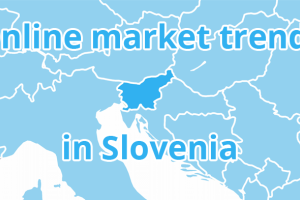Online market trends in Slovenia

In terms of ecommerce, Slovenia is not one of the popular and well-known countries. That doesn’t mean this Eastern European country has nothing to offer. With 1,500 online retailers in a country that has slightly more than 2 million inhabitants, there’s still real potential. Time to know more about this country and its ecommerce market!
For this year’s Web retailer of the Year research project, comparison shopping platform Ceneje carried out a survey among 33,000 online shoppers from Slovenia. For the fourth time the ecommerce company wanted to gain insight in the trends and dynamics of the Slovenian online market and the purchasing process of a modern smart shopper.
It found out that more Slovenian people are shopping online sometimes, as the share of consumers who purchase something at least once per month (who amount to one-third of all internet users) increased by 58 percent since 2013. And 85 percent of all local internet users purchase online at least occasionally, while this share was 78 percent in 2013. On the other hand, only 16 percent of all internet users in Slovenia do not have any experience with online shopping yet.
Slovenia is lagging behind with online purchases
According to the research, there are about 1,500 web retailers in Slovenia, a country with 2,06 million inhabitants. Ceneje says Slovenia is one of the leading countries in Europe when it comes to the impact of the internet on purchasing decisions, as the share of those who search information on products and services online before buying them, is higher than the EU average. “In Slovenia the internet has certainly a significant impact, both on online and traditional sales channels, but at the same time the number of online purchases still lags behind the EU average”, the comparison shopping platform tells us. “According to data from the European Commission, collected in May this year, in Slovenia 9 out of 10 internet users search online information about goods and services before they purchase, while only one in five actually shops online.”
The intensity of shopping by age groups
The largest share of online shoppers is in the age group of 12-24 years where 96 percent of all internet users shop online, of these 39 percent shop online at least once per month. In the age group of 25-34 years the proportion of online customers amounts to 95 percent. In this demographic group there is the largest share of intensive purchases – almost half of internet users shop online at least once a month. As expected, in the age group of 45-84 years the share of online shoppers is the lowest and it amounts to 73 percent of all internet users.
Encouraging data for cross-border ecommerce
An important result of the survey can be found in the growth of cross-border online shopping. 43 percent of Slovenian internet users still shop exclusively in national online shops, but on the other hand the proportion of those who shop abroad (meaning that out of ten online purchases at least one is performed in a foreign store) is growing and currently amounts to 57 percent of all internet users.
“It’s a fact that competitive offers from foreign online retailers are becoming increasingly relevant for Slovenian online shoppers and in the future we can certainly expect further development of cross-border ecommerce”, the ecommerce company predicts.
Some still choose not to shop online – why?
According to the research, the main two reasons for consumers not to shop online are distrust and the fact that they are accustomed to the physical store. Of those who never shop online, 84 percent claims they prefer to see the product in a physical store, 42 percent doesn’t want to share their personal data online, and one in three is concerned about the misuse of credit cards. Among the reported reasons there is also the fear that there are harder and more complicated problems online, that online consumers are less protected and that it’s easier to compare prices and products in a physical store.
The future of ecommerce in Slovenia?
“Development of ecommerce in Slovenia and in general is today intensively affected by the penetration of new technologies that shape consumers’ daily routine. The future of modern commerce will not be limited to national markets and especially not just on the internet”, Ceneje concludes. “It will consist of a network of physical locations and online sales solutions. The development of technology is increasingly enabling the growth of hybrid shopping patterns such as click & collect, which will become a key to a successful business.”

Comments